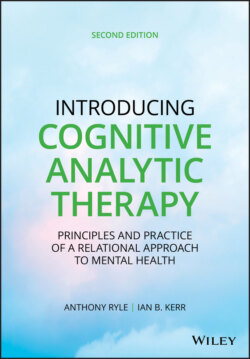Читать книгу Introducing Cognitive Analytic Therapy - Anthony Ryle - Страница 43
Concluding Remarks
ОглавлениеThis chapter has aimed to give a summary account of the theory and practice of the CAT model and its prior development. It is clear that the model will need to continue to evolve in the light of further developments and advances, both in background disciplines and in the light of research and experience in various clinical and other applications. Some of these currently ongoing developments are outlined subsequently elsewhere in this book, although inevitably some may be unpredicted, surprising, or counter‐intuitive; for example, CAT as basis for a “self help” tool (Meadows & Kellett, 2017). Further discussion and a largely sympathetic critique of the model from more explicitly socio‐political perspectives has been offered, for example, by Fozooni (2010) and more recently by various authors in Lloyd and Pollard (2018). While acknowledging the strengths of CAT, some of this critique has centered on the evolution and role of the model within established Western mental health care systems, the extent to which the model may collude with their predominantly biomedical, arguably largely apolitical, character, and an alleged uncritical acceptance within CAT of conventional diagnostic systems. Such critiques have much in common with those properly articulated by critical psychologists and psychiatrists such as Ingleby (1980), Johnstone and Dallos (2013), Hobson and Leonard (2001), Bracken and Thomas (2005), Lowenthal (2015), and Middleton (2015a, 2015b). These debates represent important aspects of a struggle toward more meaningful and humane conceptualizations of and responses to “mental disorder.” In our view, the CAT model, as outlined above and subsequently detailed below in this book, can make a significant and critical contribution to this struggle given that it is clearly predicated on a fundamentally, although not entirely, relational and socio‐cultural model of the Self (see Chapters 3 and 4) and correspondingly of the origins and character of mental health problems. Notwithstanding these important debates, the core of the CAT model and its clinical style as outlined in this chapter has, in our view, remained essentially constant and scientifically valid over a number of years now and should, we hope and anticipate, continue to inform and support a range of further developments both as a model of therapy and beyond.
